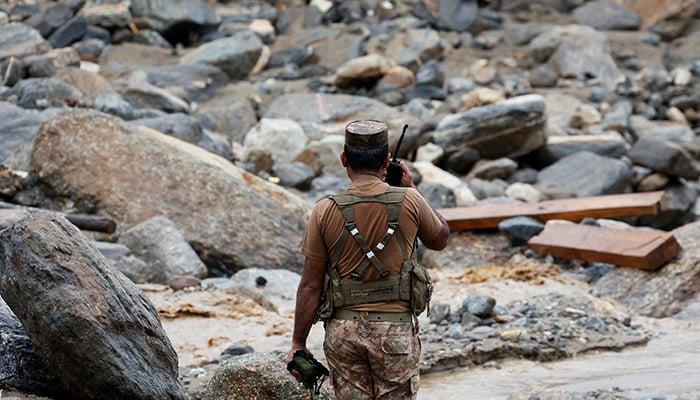- Army clears blocked roads, restore access in Shangla, Buner.
- NDMA reports 660 nationwide deaths during ongoing monsoon rains.
- KP universities closed from August 19–25 amid flood risks.
ISLAMABAD/PESHAWAR: Rescue and relief operations get underway in full swing in flood-hit districts of Khyber Pakhtunkhwa as Pakistan Army engineers are working round the clock to clear blocked roads and restore access for stranded residents after deluge and landslides wreaked havoc in the province.
The Army Engineers Corps personnel have reopened the Pir Baba bypass for all kinds of traffic and cleared debris in the Pir Baba bazaar overnight to facilitate the local population in district Buner.
In addition, the road leading to Gokand village in Buner has been cleared at three points after heavy landslides, while the Aluch–Poran road has also been restored with the help of heavy machinery.
Urban Search and Rescue teams, assisted by heavy equipment, continue to carry out operations in Bishoni and Qadir Nagar. So far, five bodies have been recovered from a stream near Bishoni. The military has vowed to continue rescue operations until full restoration in all flood-affected areas.
Flash floods triggered by heavy rains and cloudbursts have killed at least 341 people in KP since Friday, according to the Provincial Disaster Management Authority, with Buner emerging as the worst-hit district, where more than 200 lives were lost. Rescuers have faced difficulties moving heavy machinery into narrow streets, further slowing operations.
The National Disaster Management Authority (NDMA) reported that torrential rains and flooding this monsoon season have killed at least 660 people across the country since late June. KP registered the highest fatalities at 392, followed by Punjab with 164, Gilgit Baltistan with 32, Sindh with 29, Balochistan with 20, Azad Jammu and Kashmir with 15, and Islamabad with 8. Officials said cloudbursts — rare phenomena where more than 100mm of rain falls within an hour — wreaked havoc in Buner, with more than 150mm recorded on Friday morning alone.
Widespread devastation has also been reported in Peshawar, Mardan, Swabi and Abbottabad. In Swabi, at least 11 people died in flash floods on Monday. Across hilly areas, houses, buildings, vehicles and belongings were swept away.
NDMA Chairman Lieutenant General Inam Haider Malik warned of two more potential spells of rain between August 21 and September 10, cautioning that further cloudbursts “could intensify” the disaster.
Further widespread rain to hit parts of country
Meanwhile, the Pakistan Meteorological Department (PMD) has forecast further widespread rain-wind/thundershowers across Khyber Pakhtunkhwa, Punjab, Sindh, Balochistan, Kashmir, Gilgit-Baltistan, and Islamabad on Tuesday. Heavy to very heavy rainfall is expected in several regions, raising the risk of flash floods in nullahs and streams, particularly in KP, Kashmir, Gilgit-Baltistan, the Potohar region, Dera Ghazi Khan, Koh-e-Suleman, and northeastern Balochistan.
The PMD cautioned that urban flooding could hit low-lying areas of northeastern Punjab, Islamabad/Rawalpindi, Peshawar, Nowshera, and southeastern Sindh. Landslides are also feared in vulnerable hilly areas including Murree, Galliyat, Kashmir, KP, and Gilgit-Baltistan. Strong winds, lightning, and torrential downpours may damage weak structures such as mud houses, billboards, solar panels, and electric poles, the advisory added.
During the past 24 hours, heavy rain has already battered several parts of the country. Rawalakot recorded 110mm, Murree 88mm, Chakwal 84mm, Takht Bhai 80mm, and Peshawar Airport 54mm. Meanwhile, Dalbandin and Turbat were the hottest at 43°C, followed by Nokundi at 42°C.
KP universities close amid heavy rains
In response to the worsening weather situation, the Khyber Pakhtunkhwa Higher Education Department has announced the closure of all colleges and universities in the Counter Zone from August 19 to 25. The decision, according to an official notification, was taken to protect the lives of students, teachers, and staff amid the risks of cloudbursts, flash floods, and landslides.
The department has directed institutions to continue academic activities through online platforms during the closure. Provincial Higher Education Minister Meena Khan Afridi said the government was also planning relief measures in the higher education sector to ensure students do not face difficulties or disruptions in their studies due to the floods.
The KP Higher Education Department also issued a damage assessment report of colleges and universities affected by the floods. According to the report, the 300-foot boundary wall of Government Degree College Lalqila in Lower Dir has been washed away, while the water supply scheme and tube well of Government Degree College Wari in Upper Dir have been damaged.
In Shangla, the 3,000-foot boundary wall of Chakisar College has completely collapsed. Similarly, the boundary wall of Government Girls Postgraduate College in Saidu Sharif, Swat, has also been damaged, while Government Degree College Shamozai in Swat lost part of its wall to the floods.
At the University of Shangla, a 1,400-foot water pipeline was damaged, whereas at the University of Swat’s Charbagh campus, a 40-foot boundary wall collapsed. The report further noted that the residential colony boundary wall of the University of Swat was also affected.
Govt response
The federal and provincial leadership have pledged support for relief efforts. KP Chief Minister Ali Amin Gandapur announced donations from salaries — one month’s pay from the CM, 15 days from cabinet members, seven days from provincial lawmakers, two days from officers in grade 17 and above, and one day from lower staff.
Prime Minister Shehbaz Sharif also pledged the federal government’s complete support, donating one month’s salary from the federal cabinet to aid affected communities.
Federal Minister for Climate Musadik Malik assured that all roads would be reopened within 24 hours, with the Centre working “without discrimination” alongside provincial governments.
Landslides and flash floods are a recurring feature of Pakistan’s monsoon season, which typically begins in June and tapers off by late September. The rains bring South Asia about three-quarters of its annual water supply, crucial for agriculture and food security, but they also leave a trail of destruction.
According to chief meteorologist, Zaheer Babar, the country is witnessing a rise in the frequency and intensity of extreme weather events. He explained that heavy downpours in the mountains often turn into flash floods downstream, catching residents in low-lying areas off guard.
Babar noted that climate change is a key factor driving this volatility, but human practices worsen the impact. Homes built along riverbanks, constricted waterways, and garbage dumping restrict the natural flow of rainwater, amplifying the devastation.
Pakistan remains among the world’s most climate-vulnerable countries, repeatedly battered by extreme weather. In 2022, monsoon floods submerged a third of the country and claimed around 1,700 lives, underscoring the scale of the challenge.
— With additional input from Reuters and APP


